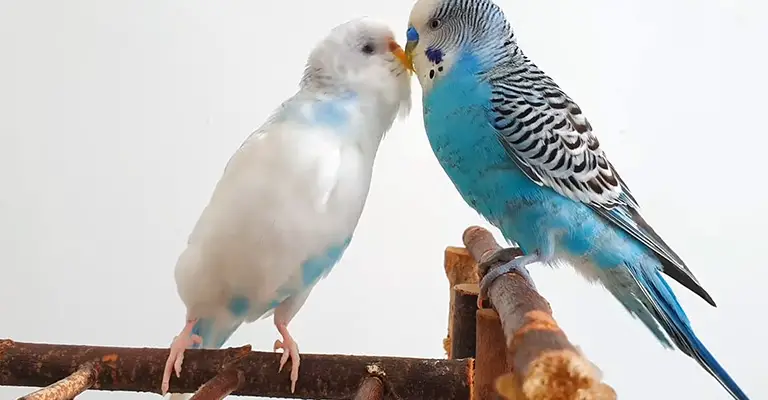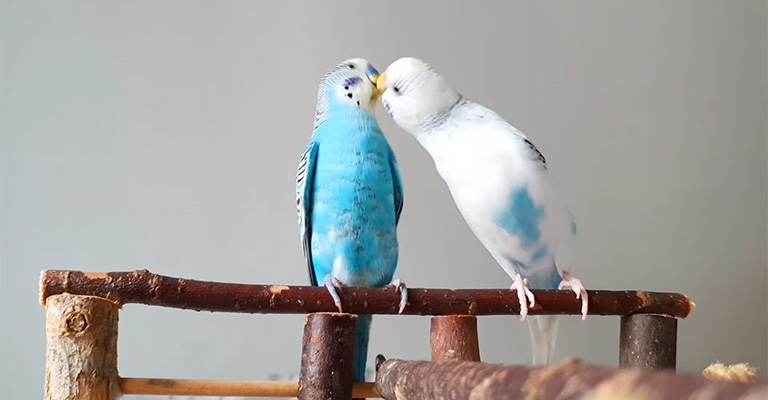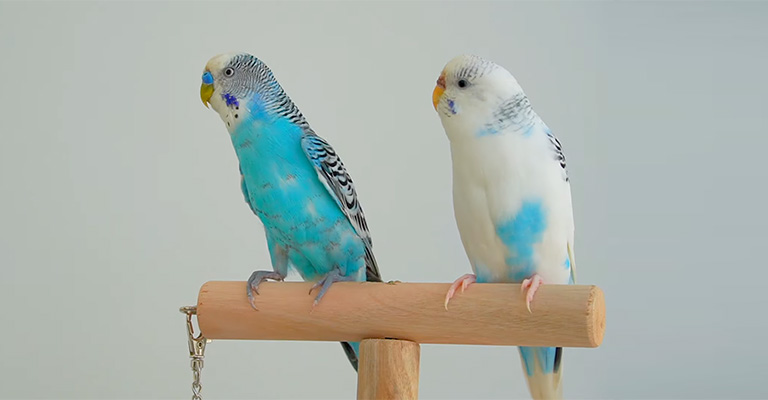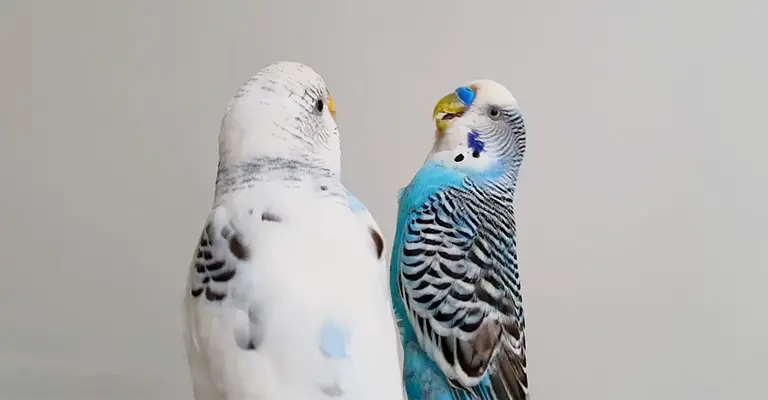Budgies, those captivating and sociable little avian companions, have a knack for melting hearts with their cheerful chirps and vibrant plumage. But what if one budgie’s charm isn’t enough?
If you’re contemplating the joys of having two budgies share your space, you’re in for a delightful journey of companionship and camaraderie.
In this exploration, we embark on a quest to uncover the dynamics of building meaningful relationships with not just one, but two of these feathered wonders.
Can you bond with two budgies? Can two budgies be friends as well as companions to you? The answer lies in the intricate dynamics that unfold when two of these lively and charming birds enter your life.
Join us as we navigate the path of double delight, uncovering the intricacies of nurturing connections, both between you and your budgies and between the budgies themselves.

Can You Bond with Two Budgies?
Can the magic of connection be doubled? The short answer is yes! Let’s unravel the layers of building relationships with multiple budgies, delving into the depths of bonding that extend not only to you but between the budgies themselves.
Individual Bonds, Shared Moments
Every budgie possesses a unique personality, and bonding with two doesn’t dilute the individual connections you form.
Each budgie can have its own special moments with you, expressing affection, seeking interaction, and creating a unique dynamic that defines your relationship.
Budding Friendships Between Budgies
When introducing two budgies to each other, they have the potential to develop a companionship of their own.
From synchronized chirps to shared grooming sessions, budgies often form bonds with their feathered peers, enriching their social lives and contributing to their overall well-being.
The Role of Your Presence
Your role as their caretaker and companion remains central in a multi-budgie setup. While each budgie may interact with you individually, your presence also contributes to the sense of security and shared experiences they enjoy together.
Time, Patience, and Equitable Attention
Balancing your attention between two budgies requires time and patience. Investing time in their individual interactions and playtime, as well as observing their interactions with each other, helps nurture a harmonious environment where bonds can flourish.
Strengthening the Trio Bond

While bonding with two budgies is rewarding, it’s equally essential to create an environment where all three of you can thrive.
Engaging in activities together, providing varied forms of enrichment, and ensuring that jealousy or competition for attention doesn’t emerge are key considerations.
Respect for Individual Preferences
Just as in any relationship, respecting individual preferences is crucial. One budgie might be more sociable, while the other might need more space. Recognizing and honoring these differences ensures that each budgie feels valued and understood.
Social Interactions and Learning
Having multiple budgies can offer a unique opportunity for social learning. New behaviors, vocalizations, and even playful antics can be picked up from each other, contributing to a lively and enriching environment.
Factors to Consider
While bonding with two budgies is certainly possible, it’s important to consider factors like cage size, budgie personalities, and potential challenges.
Proper introductions, monitoring interactions, and ensuring that neither budgie is left out are vital considerations.
Bonding Beyond Boundaries
The heartwarming experience of bonding with two budgies extends the boundaries of connection.
The shared moments, the intertwining of melodies, and the intricate dance of companionship create a tapestry of joy that enriches your life and the lives of your feathered friends.
How to Introduce a Second Budgie?

Introducing a second budgie to your existing feathered friend requires careful planning and a gradual approach to ensure a smooth transition and harmonious coexistence. Here’s a step-by-step guide on how to introduce a second budgie:
Choosing the Right Match
Select a budgie that is of a similar age and size to your current budgie. This can reduce the potential for dominance conflicts and make the bonding process smoother.
Quarantine Period
Before introducing the new budgie to your current one, quarantine the new bird in a separate cage for at least 30 days. This helps ensure that the new budgie is healthy and won’t introduce any illnesses to your current budgie.
Parallel Presence
Place the new budgie’s cage near the cage of your current budgie. This allows them to become familiar with each other’s presence and vocalizations without direct contact.
Gradual Introduction
After the quarantine period, start with short and supervised face-to-face interactions. Place the cages close to each other and observe their behavior. If they seem curious and not overly aggressive, you can proceed to the next step.
Neutral Territory
Move both cages to a neutral area outside of their usual living spaces. This prevents territorial behavior from either budgie and encourages a more neutral and open interaction.
Cage Swapping
Swap the budgies’ cages for short periods each day. This allows them to explore each other’s environment and scent without direct contact.
Shared Playtime
When both budgies seem comfortable, allow them to have supervised playtime outside of their cages together. Offer toys, perches, and treats to create positive associations with each other’s presence.
Full-Time Coexistence
Once they’ve shown positive interactions during playtime, you can consider placing both budgies in the same cage. Ensure that the cage is large enough to accommodate both comfortably.
Monitor Behavior
Keep a close eye on their interactions for the first few days. Occasional squabbles are normal as they establish hierarchy, but aggressive behavior should be addressed promptly.
Provide Multiple Resources
Ensure there are plenty of food and water sources, toys, and perches in the cage to prevent resource guarding and competition.
Patience and Observation
The bonding process may take time, and personalities play a role in how quickly they become friends. Be patient and observe their interactions to ensure a positive environment.
Individual Attention
While encouraging the new bond, continue to provide individual attention to both budgies to avoid jealousy or feelings of neglect.
Signs of Compatibility
Look for signs of compatibility, such as preening each other, sleeping close together, and chirping harmoniously. These indicate that their bond is strengthening.
Remember that not all budgies will become fast friends, and some may need more time to adjust than others. Always prioritize the safety and well-being of both budgies throughout the introduction process.
If at any point aggression becomes excessive or there are serious conflicts, consult an avian behaviorist or veterinarian for guidance.
How Do You Bond with Aggressive Budgies?

Bonding with aggressive budgies requires patience, understanding, and a gradual approach to help them overcome their fear or negative behaviors. Here’s a step-by-step guide to help you build trust and establish a positive relationship with aggressive budgies:
Respect Their Space
Give your budgie plenty of space and time to adjust to their environment. Avoid making sudden movements or loud noises that could startle them further.
Observe and Understand
Take time to observe their behavior and try to understand what triggers their aggression. It could be fear, territorial behavior, or past negative experiences.
Start Slowly
Begin by simply spending time near their cage without attempting to interact. Talk to them in a soothing tone to get them used to your presence.
Offer Treats
Win their trust by offering their favorite treats through the cage bars. This helps them associate your presence with positive experiences.
Gradual Movement
When they become comfortable with treats, move on to extending your hand inside the cage without making sudden moves. Allow them to approach you at their own pace.
Respect Body Language
Pay attention to their body language. If they show signs of stress or aggression (fluffed feathers, hissing, beak snapping), back away slowly and give them space.
Use a Perch or Stick
To avoid being bitten, offer your hand on a perch or stick initially. This allows them to approach without direct contact.
Desensitization
Gradually expose them to things that trigger aggression in a controlled manner. For instance, introduce a toy or object that they react negatively to and reward them for calm behavior.
Offer Playtime
Provide supervised out-of-cage playtime in a safe, enclosed space. Allow them to explore and get used to your presence without feeling cornered.
Be Patient
Building trust takes time. Avoid rushing or forcing interactions. Let them set the pace and decide when they’re ready to engage.
Consistency is Key
Consistency in your approach is essential. Spend time with them daily, and make interactions positive and non-threatening.
Positive Reinforcement
Reward calm and non-aggressive behavior with treats, praises, and gentle interactions. This reinforces the idea that good behavior leads to positive outcomes.
Gradual Steps
As they become more comfortable, gradually increase your interaction. Try stepping up on your finger, target training, or teaching simple tricks. Never use punishment as it can worsen their aggression and damage trust.
Consult a Professional
If aggression persists or worsens, consider seeking advice from an avian behaviorist or veterinarian with experience in bird behavior.
Every budgie is unique, and some may take longer than others to overcome aggression. Be patient and persistent, and let your budgie’s comfort level guide the process.
Over time, consistent positive interactions can help transform an aggressive budgie into a trusting and friendly companion.
FAQs
Yes, they can form strong bonds with both you and each other. Your presence and interaction remain valuable, and having a companion doesn’t diminish their ability to connect with humans.
Yes, you can bond with both budgies individually. Spending quality time with each, offering treats, and engaging in positive interactions help build separate and strong relationships.
While they may engage with each other, budgies often seek interaction and stimulation from their human companions. They may be more confident and expressive with their friend around.
Provide a spacious cage with perches, toys, and space for both budgies to move around comfortably. Introduce them gradually and monitor their interactions to ensure they get along. Offer activities they can enjoy together, like playtime and shared toys.
Having a companion doesn’t necessarily make budgies less tame. Continue interacting with them regularly to maintain your bond and reinforce their comfort with human interaction.
Conclusion
As our exploration draws to a close, the question of whether you can bond with two budgies finds an answer in the resounding affirmative.
The journey of building relationships with these feathered companions is not just a possibility but a rewarding adventure in itself.
The bonds you cultivate with your budgies are as unique as their vibrant personalities. While the dynamics might differ when there are two, the potential for connection remains just as strong.
Sharing your time, attention, and affection between two budgies requires patience and understanding. With time, you’ll witness their interactions unfold – playful squabbles, companionable grooming, and moments of shared comfort.
In the heartwarming world of budgie companionship, the synergy of shared moments, synchronized chirps, and the rhythm of fluttering wings reaffirms that the beauty of connection knows no boundaries.